|
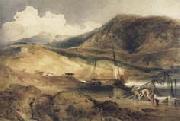 |
John sell cotman
|
|
English Romantic Painter, 1782-1842
English painter and etcher. Cotman was born in the parish of St Mary Coslany, Norwich, the son of Edmund Cotman, a hairdresser, later a haberdasher, and Ann Sell. In 1793 he entered Norwich Grammar School as a 'freeplacer'. In 1798 he moved to London, where he worked as an assistant to the publisher Rudolph Ackermann. Following in the footsteps of Turner and Thomas Girtin he joined Dr Monro's 'Academy' in 1799 and became a member of the sketching society that had developed around the personality and talent of Girtin. |
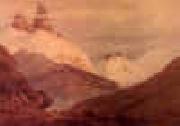 |
John Robert Cozens
|
|
British
1752-1797
). Painter, draughtsman and printmaker, son of (1) Alexander Cozens.
He was taught by his father, and an album by John Robert (Aberystwyth, N. Lib. Wales) indicates that he also learnt to sketch landscape directly from nature. The album contains drawings that record sketching tours to Nacton, near Ipswich, Suffolk (Aug 1768); day trips to the outskirts of London: Greenwich and Blackheath (1768, 1771), Epsom (1768) and Hampstead (1770-71); and a trip to Matlock, Derbys (June 1772). The earliest of these sketches are careful pencil drawings, some later reworked in pen, ink and wash, and there is at least one attempt at added colour. Later drawings are freer, either noting an idea for a composition or recording light and shade with rapid washes of ink over pencil. His father worked mainly in monochrome brown or grey washes, and John Robert earliest exhibits (he exhibited at the Society of Artists every year from 1767 to 1771) were also in this medium. |
 |
John R.Chapin
|
|
1823 - 1904,was a 19th-century American artist and illustrator, who worked for Harper's Magazine. He was especially noted for a series of illustrations entitled Artist life in the highlands of New Jersey published in April 1860 which gave a realistic depiction of the daily life of miners. |
 |
John Maler Collier
|
|
(27 January 1850 - 11 April 1934), called 'Jack' by his family and friends, was a leading English artist, and an author. He painted in the Pre-Raphaelite style, and was one of the most prominent portrait painters of his generation. Both his marriages were to daughters of Thomas Henry Huxley. He studied painting at the Munich Academy where he enrolled on 14 April 1875 (Register: 3145) at the age of 25.
Collier was from a talented and successful family. His grandfather, John Collier, was a Quaker merchant who became a Member of Parliament. His father (who was a Member of Parliament, Attorney General and, for many years, a full-time judge of the Privy Council) was created the first Lord Monkswell. He was also a member of the Royal Society of British Artists. John Collier's elder brother, the second Lord Monkswell, was Under-Secretary of State for War and Chairman of the London County Council.
Collier's first wife, Marian Huxley, 1883In due course, Collier became an integral part of the family of Thomas Henry Huxley PC, sometime President of the Royal Society. Collier married two of Huxley's daughters and was "on terms of intimate friendship" with his son, the writer Leonard Huxley. Collier's first wife, in 1879, was Marian (Mady) Huxley. She was a painter who studied, like her husband, at the Slade and exhibited at the Royal Academy and elsewhere. After the birth of their only child, a daughter, she suffered severe post-natal depression and was taken to Paris for treatment where, however, she contracted pneumonia and died in 1887.
In 1889 Collier married Mady's younger sister Ethel Huxley. Until the Deceased Wife's Sister's Marriage Act 1907 such a marriage was not possible in England, so the ceremony took place in Norway. Collier's daughter by his first marriage, Joyce, was a portrait miniaturist, and a member of the Royal Society of Miniature Painters. By his second wife he had a daughter and a son, Sir Laurence Collier KCMG, who was the British Ambassador to Norway 1941-51.
|
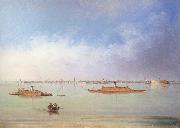 |
John Gadsby Chapman
|
|
American Painter, 1808-1889,was an American artist famous for The Baptism of Pocahontas, which was commissioned by the United States Congress and hangs in the United States Capitol rotunda. John Chapman was born in 1808 in Alexandria, Virginia. Chapman began his study of art in Philadelphia for two years, then departed for Europe where he eventually spent time in Italy. In 1831, Chapman returned to his hometown of Alexandria, and exhibited his artwork in the nearest metropolitan areas, such as Washington, D.C., Richmond, and Philadelphia. He specialized in landscapes and portraits. By 1834, Chapman had moved to New York City and become a member of the National Academy of Design, and found work as an illustrator. In New York, Chapman embarked on a series of historic paintings, such as Landing at Jamestown and the Crowning of Powhatan. The success of these paintings helped Chapman land a commission from the United States Congress in February 1837 to paint a historical scene for the rotunda of the Capitol building. For this work, Chapman received a total payment of $10,000. On November 30th, 1840, The Baptism of Pocahontas was formally unveiled in the Capitol rotunda. On the swell of this success, Chapman moved his family to Rome, and made an earnest living selling paintings of rural Campagna to American visitors. However, at the onset of the American Civil War, the tourist industry dried up, affecting Chapman fortunes greatly. In addition, Chapman own son, Conrad Chapman, returned to America to fight on the side of the Confederate States of America. The economic deprivation inflicted on Chapman during the 1860s became insurmountable. In Rome, he was forced to live off the kindness of fellow expatriates, and finally returned to America, sick and poor, to spend his last days with another son, John Linton Chapman, in Brooklyn, New York. It was there, in 1889, that he died a pauper. |
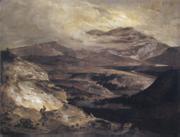 |
John Crome
|
|
English Romantic Painter,
1768-1821
was an artist in the Romantic era. Born in the English city of Norwich, John Crome is also known as Old Crome to distinguish him from his son, John Berney Crome, who was also a well-known artist. The son of a weaver, he was apprenticed to a coach painter or sign painter. It is said that he acquired his skills by copying Gainsboroughs and Hobbemas owned by Thomas Harvey of Old Catton, his patron from 1790. The two main influences on his style are considered Dutch 17th century painting and Wilson. Crome went on to become the founder of the Norwich school of painters, of which John Sell Cotman is another famous member. He worked both in watercolour and oil. His oil paintings alone number in excess of 300. Many can be seen at major galleries around the world, including the Tate Gallery and the Royal Academy, but he is also well represented in Norwich itself. He also produced etchings and taught art. One of his pupils was James Stark. Crome's Broad and nearby Crome's Farm. |
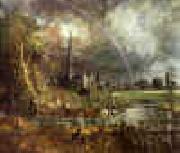 |
John Constable
|
|
1776-1837
British
John Constable Locations
1837). English painter and draughtsman. His range and aspirations were less extensive than those of his contemporary J. M. W. Turner, but these two artists have traditionally been linked as the giants of early 19th-century British landscape painting and isolated from the many other artists practising landscape at a time when it was unprecedentedly popular. Constable has often been defined as the great naturalist and deliberately presented himself thus in his correspondence, although his stylistic variety indicates an instability in his perception of what constituted nature. He has also been characterized as having painted only the places he knew intimately, which other artists tended to pass by. While the exclusivity of Constable approach is indisputable, his concern with local scenery was not unique, being shared by the contemporary Norwich artists. By beginning to sketch in oil from nature seriously in 1808, he also conformed with the practice of artists such as Thomas Christopher Hofland (1777-1843), William Alfred Delamotte, Turner and, particularly, the pupils of John Linnell. Turner shared his commitment to establishing landscape as the equal of history painting, despite widespread disbelief in this notion. Nevertheless, although Constable was less singular than he might have liked people to believe, his single-mindedness in portraying so limited a range of sites was unique, and the brilliance of his oil sketching unprecedented, while none of his contemporaries was producing pictures resembling The Haywain (1821; London, N.G.) or the Leaping Horse (1825; London, RA). This very singularity was characteristic of British artists at a time when members of most occupations were stressing their individuality in the context of a rapidly developing capitalist economy |
 |
John Closterman
|
|
John Closterman (1660-1711) (also spelled Cloosterman, Klosterman), portrait-painter, born in Osnabruck, the son of an artist, who taught him the rudiments of design.
In 1679 he went to Paris, accompanied by his countryman Tiburen, and there worked under Francois de Troy. In 1681 he came to England, and painted draperies for John Riley, at whose death, in 1691, Closterman finished several of his portraits. This recommended him to the Duke of Somerset, but he lost his favour on account of a dispute about a picture of Guercino, specially acquired for his grace, and which was afterwards purchased by Lord Halifax. In 1696 he was invited to the court of Spain, and executed the portraits of the king and queen; he also went to Italy twice, and made several acquisitions of works of art. On returning to England he obtained considerable employment, and married an Englishwoman. He buried his wife, Hannah, on 27 January 1702. According to Arnold Houbraken, he later took a mistress, who then ruined him by her extravagant habits, and ultimately left him in a state of dejection of body and mind that led to his ultimate decline. Jacob Campo Weyerman, who took much of his biographical material from Houbraken, states "Closterman had taken a beautiful mistress who, while he was away in the country, robbed him of his valuables and disappeared, actions which drove the painter into madness".
He died in 1711, and was buried in Covent Garden churchyard. |
 |
John Cleveley
|
|
circa 1712-77 English painter, born in Southwark, London. Cleveley did not come from an artistic background |
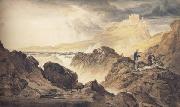 |
John Christian Schetky
|
|
(1778-1874)
Scottish painter. Schetky came from a cultured family: his father, Johann (1737-1824), was a German composer, and his mother, Maria, was the trumpeter Joseph Reinagle's sister. He took drawing lessons from Alexander Nasmyth and received a good education in Edinburgh before embarking on a Continental tour in 1801. After a spell as a drawing-master at the Royal Military College, Great Marlow, he was appointed Professor of Drawing at the Royal Naval College, Portsmouth, in 1811, a post he held for 25 years. He exhibited regularly at the Royal Academy between 1805 and 1872, his subjects ranging from ship portraits and royal embarkations to reconstructions of earlier sea battles of the time of Nelson. In 1820 he was made Marine Painter in Ordinary to George IV and was granted the same title by Queen Victoria in 1844. |
 |
John Charles Dollman
|
|
British, 1851-1934, He was an English painter and illustrator. Dollman was born in Hove on 6 May 1851 and moved to London to study at South Kensington and the Royal Academy Schools, after which he set up a studio at Bedford Park, London. He exhibited at the Royal Academy from 1870 to 1912, and was elected RWS (Member of the Royal Watercolour Society) in 1913. Dollman was also an illustrator, working in black and white or colour for magazines such as the Graphic during and after the 1880s. Some of his early work has been said to have influenced Van Gogh . A central theme was ambitious mythological pictures such as a Viking Foray, a Viking horde entitled the Ravagers, The Unknown (1912), featuring a girl surrounded by chimps and Orpheus and his Lute with Lions. He also produced bold compositions of animals and people such as Robinson Crusoe and His Man Friday, Polo and Mowgli made leader of the Bandar-log (1903) . His best known work is possibly A London Cab Stand (1888) , focussing on a group of horses in a stormy scene . He composed at least three variants of this picture, and there are other instances where he made copies or near-copies of individual pictures. In the 1890s he painted pictures of soldiers, and some less well regarded genre pictures of people with animals. He also painted wild animal pictures without attempting any narrative content . Dollman's works are in the collections of various galleries. The Immigrants' Ship (1884) is in the Art Gallery of South Australia, Adelaide . 'The Ravager' is owned by the Trustees of the Royal Watercolour Society, London, [8]. A version of The Unknown is in the Laing Art Gallery, Newcastle. A London Cab Stand is in the London Museum. A Dog's Home, Table d'Hote (1879) is in the Walker Art Gallery, Liverpool , and During the Time of the Sermonses (1896), an odd picture of a pair of religious people approaching two golfers, is in the collection of the Harris Museum, Preston , while 'Famine' (1904) is at the Salford Museum and Art Gallery Dollman died on 11 December 1934, aged 83. |
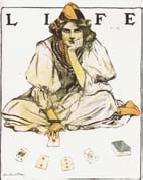 |
John Cecil Clay
|
|
Illustrator and genre, caricature painter
American
1875-1930
American illustrator known for genre and caricature paintings. Clay was born in Ronceverte, West Virginia to an long-time Southern family. He was a student of Henry Siddons Mowbray at the Art Students League of New York and had a graphic style that was suited to illustration. A reoccurring subject was pretty young women. During his life he worked for Life and Frank Leslie's Popular Monthly. He was a member of Society of Illustrators and was represented at the St. Louis Exposition-World's Fair 1904. Apart from the above mentioned magazines he also worked as an illustrator for The Century Magazine, Saturday Evening Post and Good Housekeeping. |
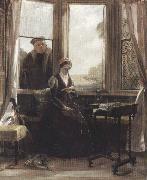 |
John callcott horsley,R.A.
|
|
1817-1903
English painter. A nephew of the landscape painter Augustus Wall Callcott, and later Isambard Kingdom Brunel's brother-in-law, he was born into the artistic establishment. He was educated at Henry Sass's Academy and at the Royal Academy. Although he executed two frescoes for the Houses of Parliament (The Spirit of Religion, 1847; London, House of Lords; Satan Wounded by Ithuriel's Lance, 1848; London, Pal. Westminster), his career began with portraiture. Success later came with literary subjects, |
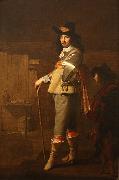 |
Johannes Cornelisz Verspronck
|
|
(between 1600 and 1603, Haarlem - buried June 30, 1662, Haarlem) was a gifted Dutch Golden Age portraitist.
He was the son of the painter Cornelis Engelsz from Gouda, who taught him to paint portraits. In 1632 he became a member of the Haarlem Guild of St. Luke and started a successful career as a portraitist of mostly Catholic sitters in Haarlem. He may have been a Frans Hals pupil, and was strongly influenced by him, especially in his natural expressions and relaxed poses. He is best known for his exactness in painting details such as jewelry and lace, which made him quite popular with female sitters. Most notably, he won a lucrative commission in 1642 for a group portrait of the regentesses of the St. Elisabeth Gasthuis, at the time the wealthiest charity institution in Haarlem. This was won at the expense of Frans Hals himself, who had painted the regents of the St. Elisabeth Gasthuis in 1641 and fully expected to win the commission for the women. |
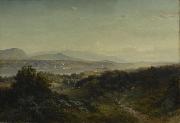 |
Johann Hermann Carmiencke
|
|
Johann Hermann Carmiencke, a landscape painter and etcher, was born at Hamburg in 1810. He went to Dresden in 1831 as a journeyman painter, and while there studied in Dahl's school. Thence he went to Copenhagen in 1834, where he studied in the Academy, and presently repairing to Leipsic, received instruction there from Sohonberg. Returning to Copenhagen in 1838, he proceeded to travel as an artist in Sweden, Bavaria, and the Tyrol, visiting Italy from 1845 to 1846. He was then appointed court painter to Christian VIII, for whom he executed many works. In consequence of the war, he went in 1851 to New York, where he was well received, and admitted into the Academy of Brooklyn. His works were mainly groups of mountain ranges, which were very effectively rendered, and possessed an excellent tone the execution being simple and true to nature. The 'Mountain Tarn' and the 'View on the Zillerthal' may be particularly noticed. There are thirty-five careful etchings of landscapes by him, some of which were published by the Art Association of Copenhagen in 1850 and 1851. He died at New York in 1867. |
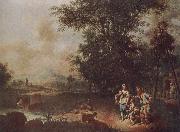 |
Johann Conrad Seekatz
|
|
1719-1768 Rococo,German,German painter. He studied with his brother, Johann Ludwig Seekatz (b 1711), and with Philipp Hieronymus Brinckmann (1709-61) in Mannheim (1748-51); he became court painter to Landgraf Ludwig VIII von Hesse-Darmstadt in Darmstadt in 1753. |
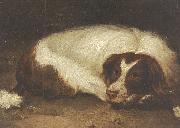 |
Johann Christoph Rincklake
|
|
Johann Christoph Rincklake (1764-1813).
Date of birth and death 19 October 1764(1764-10-19) and 19 June 1813(1813-06-19) .
Location of birth and death, Harsewinkel and Munster. |
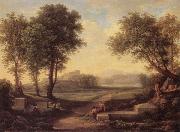 |
Johann Christian Reinhart
|
|
German , 1761-1847
He revealed an interest in art while still at school and, though he began to study theology in Leipzig in 1778, he soon transferred to the private art academy of Adam Friedrich Oeser (1717-99). Here he made copies of the work of his teacher and drew after plaster casts of antique statues. The Liber Veritatis, a collection of 200 drawings by Claude Lorrain, was also used as a model and had an important influence on him. In 1783 he went to Dresden where he was especially attracted to the Dutch landscape paintings in the Gem?ldegalerie. In 1785 Reinhart returned to Leipzig where he made the acquaintance of the German poet Friedrich Schiller, with whom he had a lifelong friendship, and to whom he later dedicated an etching of a heroic landscape (1800). From 1786 to 1789, while resident at the court of the Duke of Sachsen-Meiningen, he explored the Thuringian countryside on foot, making sketches as he went. |
 |
Johann Christian Brand
|
|
(March 6, 1722 ?C June 12, 1795)was an Austrian painter (son of the German painter Christian Hilfgott Brand (1694-1756) who taught in Vienna with Karl Aigen) and brother of Friedrich August Brand.Johann Christian Brand influenced ending the baroque era of landscape painting. He died in Vienna.
Johann Christian Brand was born in Vienna on March 6, 1722. Influential in ending the baroque era, Johann studied at the Vienna Academy from 1736.He was awarded with the titles Kammermaler* in 1766 and "Professor of Landscape Drawing" in 1772. |
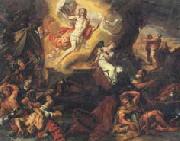 |
Johann Carl Loth
|
|
German Baroque Era Painter, 1632-1698
was a German painter, born in Munich but active most of his life in Venice. He is also called Johann Karl, Carlotto, and Carlo Lotti. He was the son and pupil of Johann Ulrich Loth (1590- 1662). He was commissioned to paint for the emperor Leopold in Vienna. He was influenced by Pietro Liberi. His brother Franz Loth was also a painter in Venice and Germany. He had numerous pupils including Willem Drost, Cornelis de Bruijn, Johann Michael Rottmayr, Paul Strudel, Santo Prunati, Daniel Seiter, and Giovan Battista Langetti. |
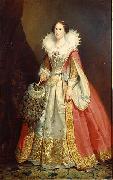 |
Johan Christoffer Boklund
|
|
(15 July 1817 - 9 December 1880) was a Swedish history, genre, and portrait painter from Kulla-Gunnarstorp in Scania.He was the son of a gardener. At the age of fifteen, Boklund came to Lund, where he worked on illustrations for Sven Nilsson's works on Scandinavian fauna (under the supervision of Magnus Körner). He then became a student at the Royal Danish Academy of Fine Arts in Copenhagen where J. L. Lund was his teacher.
In 1837, Boklund went to Stockholm and began studying at the Royal Swedish Academy of Arts. He made a living as a lithograph and drawing teacher, and produced several small genre paintings of the everyday life (such as Flicka med blomster (English: Girl with flowers) and Köksinteriör (English: Kitchen interior)) and history paintings of the 17th century (such as Gustaf Adolfs afsked från Maria Eleonora (English: Gustaf Adolf's farewell from Maria Eleonora), which was awarded with a medal at the academy).
Together with fellow Swedish painter Johan Fredrik Höckert, Boklund traveled to Munich in Germany in 1846 and stayed there for eight years. During the summers he went on study trips to Bavaria, Tyrol, and northern Italy. During this period, Boklund primarily devoted his painting to the history genre with subjects from the 17th century, but he also made some paintings depicting picturesque and architectural interior. In 1853, he sent his painting Den nyfikne trumpetaren (English: The curious trumpet player) home to Sweden and it earned him a scholarship from the government. This allowed Boklund to move to Paris, where he worked at Thomas Couture's atelier from 1854 to 1855. In December 1855 he returned to Sweden. |
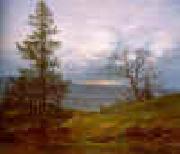 |
Johan Christian Dahl
|
|
1788-1857
Norwegian
1857). Norwegian painter and collector, active in Germany. His paintings, imbued with Romantic and patriotic sentiments, had a strong influence on the landscape tradition both in Germany (especially Dresden) and in his native Norway. |
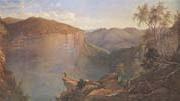 |
JH Carse
|
|
Australian Painter, ca.1819-1900 |
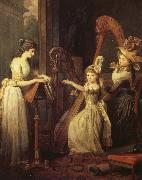 |
jeremy collier
|
|
1650 C 1726, English clergyman. Collier was imprisoned as one of the nonjurors, who refused to pledge allegiance to William III and Mary II. He later was outlawed (1696) for absolving on the scaffold two of those involved in the assassination plot against William. Collier's principal fame comes from his Short View of the Immorality and Profaneness of the English Stage (1698) and Ecclesiastical History of Great Britain (1708, 1714). In 1713 he was ordained a nonjuring bishop. |
 |
jean-simeon chardin
|
|
Jean-Baptiste-Simeon Chardin, född 2 november 1699 i Paris, död 6 december 1779 i Paris, var en fransk målare. Mästare på stilleben och genrebilder.
Chardins blygsamma läggning, personliga stil och valet av motiv från medelklassens vardagsliv försenade hans succe i Bouchers och Fragonards Frankrike, men 1728 invaldes han i Franska akademin samtidigt som hans genrebilder genom gravörernas försorg blev populära.
När 1700-talets hovkonst inte längre var populär, steg Chardins popularitet. De enkla kompositionerna, de ensamma gestalterna i form av köksflickor i arbete eller barn försjunkna i sina lekar, påverkade målare som på 1800-talet målade vardagsmotiv. Manet influerades starkt av den lugna klarheten i Chardins stilleben, liksom Courbet hade påverkats före honom. |
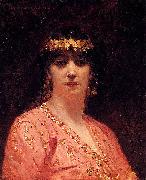 |
Jean-Joseph Benjamin-Constant
|
|
(also known as Benjamin Constant), born Jean-Joseph Constant (10 June 1845 - 26 May 1902), was a French painter and etcher best known for his Oriental subjects and portraits.
Benjamin-Constant was born in Paris. He studied at the Ecole des Beaux-Arts in Paris, where he was a pupil of Alexandre Cabanel. A journey to Morocco in 1872 strongly influenced his early artistic development and lead him to produce Romantic scenes under the spell of Orientalism. Among his noted works in this vein are Last Rebels, Justice in the Harem (both in the Luxembourg Gallery), Les Cherifas, and Moroccan Prisoners (Bordeaux). His large canvas, The Entrance of Mahomet II into Constantinople (Toulouse Museum), received a medal in 1876.
After 1880, he changed his manner, devoting himself to mural decorations and to portraits. Prominent examples include the great plafond in the Hôtel de Ville, Paris, entitled Paris Convening the World; his paintings in the New Sorbonne, representing Literature, The Sciences, and the Academy of Paris; and the plafond of the Opera Comique theatre. He was distinguished as a portrait painter, especially in England, where he was a favorite of the aristocracy. His portrait Mons fils Andra (Luxembourg) was awarded a medal of honor at the Salon in 1896.
Benjamin-Constant painted Pope Leo XIII, Queen Alexandra of England (1901), Lord John Lumley-Savile, and Henri Blowitz (1902). He was made a member of the Institute in 1893, and was a commander of the Legion of Honor. He visited the United States several times, and painted a number of portraits. The Metropolitan Museum of Art in New York owns a large mural decoration by Benjamin-Constant entitled Justinian in Council.
|
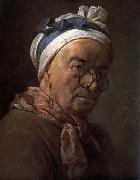 |
jean-Baptiste-Simeon Chardin
|
|
1699-1779
was an 18th-century French painter. He is considered a master of still life.Chardin was born in Paris, the son of a cabinetmaker, and rarely left the city. He lived on the Left Bank near Saint-Sulpice until 1757, when Louis XV granted him a studio and living quarters in the Louvre.Chardin entered into a marriage contract with Marguerite Saintard in 1723, whom he did not marry until 1731.He served apprenticeships with the history painters Pierre-Jacques Cazes and Noël-Nicholas Coypel, and in 1724 became a master in the Academie de Saint-Luc. Upon presentation of The Ray in 1728, he was admitted to the Academie Royale de Peinture et de Sculpture. The following year he ceded his position in the Academie de Saint-Luc. In November of 1731 his son Jean-Pierre was baptized, and a daughter, Marguerite-Agn's, was baptized in 1733. In 1735 his wife Marguerite died, and within two years Marguerite-Agn's had died as well.Beginning in 1737 Chardin exhibited regularly at the Salon. He would prove to be a 'dedicated academician', regularly attending meetings for fifty years, and functioning successively as counsellor, treasurer, and secretary, overseeing in 1761 the installation of Salon exhibitions. In 1744 he entered his second marriage, this time to Françoise-Marguerite Pouget. The following year a daughter, Angelique-Françoise, was born, but she died in 1746. In 1752 Chardin was granted a pension of 500 livres by Louis XV. At the Salon of 1759 he exhibited nine paintings; it was the first Salon to be commented upon by Denis Diderot, who would prove to be a great admirer and public champion of Chardin's work.Beginning in 1761, his responsibilities on behalf of the Salon, simultaneously arranging the exhibitions and acting as treasurer, resulted in a diminution of productivity in painting, and the showing of 'replicas' of previous works.In 1763 his services to the Academie were acknowledged with an extra 200 livres in pension. In 1765 he was unanimously elected associate member of the Academie des Sciences, Belles-Lettres et Arts of Rouen, but there is no evidence that he left Paris to accept the honor.By 1770 Chardin was the 'Premiere peintre du roi', and his pension of 1,400 livres was the highest in the Academy.In 1772 Chardin's son, |
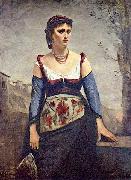 |
Jean-Baptiste-Camille Corot
|
|
was a French landscape painter and printmaker in etching. Corot was the leading painter of the Barbizon school of France in the mid-nineteenth century. He is a pivotal figure in landscape painting and his vast output simultaneously references the Neo-Classical tradition and anticipates the plein-air innovations of Impressionism.
|
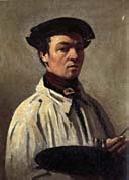 |
Jean-Baptiste Corot
|
|
1796-1875
was a French landscape painter and printmaker in etching. Corot was the leading painter of the Barbizon school of France in the mid-nineteenth century. He is a pivotal figure in landscape painting and his vast output simultaneously references the Neo-Classical tradition and anticipates the plein-air innovations of Impressionism. Camille Corot was born in Paris in 1796, in a house at 125 Rue du Bac, now demolished. His family were bourgeois people his father was a wigmaker and his mother a milliner and unlike the experience of some of his artistic colleagues, throughout his life he never felt the want of money, as his parents made good investments and ran their businesses well. After his parents married, they bought the millinery shop where she had worked and he gave up his career as a wigmaker to run the business side of the shop. The store was a famous destination for fashionable Parisians and earned the family an excellent income. Corot was the middle of three children born to the family, who lived above their shop during those years. Corot received a scholarship to study in Rouen, but left after having scholastic difficulties and entered a boarding school. He was not a brilliant student, and throughout his entire school career he did not get a single nomination for a prize, not even for the drawing classes. Unlike many masters who demonstrated early talent and inclinations toward art, before 1815 Corot showed no such interest. During those years he lived with the Sennegon family, whose patriarch was a friend of Corot's father and who spent much time with young Corot on nature walks. It was in this region that Corot made his first paintings after nature. At nineteen, Corot was a big child, shy and awkward. He blushed when spoken to. Before the beautiful ladies who frequented his mother's salon, he was embarrassed and fled like a wild thing Emotionally, he was an affectionate and well-behaved son, who adored his mother and trembled when his father spoke. When Corot's parents moved into a new residence in 1817, the twenty-one year old Corot moved into the dormer-windowed room on the third floor, which became his first studio as well. With his father's help he apprenticed to a draper, but he hated commercial life and despised what he called "business tricks", yet he faithfully remained in the trade until he was 26, when his father consented to his adopting the profession of art. Later Corot stated, I told my father that business and I were simply incompatible, and that I was getting a divorce. The business experience proved beneficial, however, by helping him develop an aesthetic sense through his exposure to the colors and textures of the fabrics. Perhaps out of boredom, he turned to oil painting around 1821 and began immediately with landscapes |
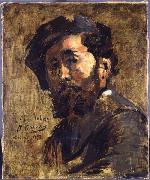 |
Jean-Baptiste Carpeaux
|
|
(May 11, 1827 - October 12, 1875) was a French sculptor and painter.
Born in Valenciennes, Nord, son of a mason, his early studies were under François Rude. Carpeaux entered the Ecole des Beaux-Arts in 1844 and won the Prix de Rome in 1854, and moving to Rome to find inspiration, he there studied the works of Michelangelo, Donatello and Verrocchio. Staying in Rome from 1854 to 1861, he obtained a taste for movement and spontaneity, which he joined with the great principles of baroque art. Carpeaux sought real life subjects in the streets and broke with the classical tradition.
While a student in Rome, Carpeaux submitted a plaster version of Pe - heur napolitain e la coquille, the Neapolitan Fisherboy, to the French Academy. He carved the marble version several years later, showing it in the Salon exhibition of 1863. It was purchased for Napoleon III's empress, Eugenie. The statue of the young smiling boy was very popular, and Carpeaux created a number of reproductions and variations in marble and bronze. There is a copy, for instance, in the Samuel H. Kress Collection in the National Gallery of Art in Washington D.C.. Some years later, he carved the Girl with a Shell, a very similar study.
In 1861 he made a bust of Princess Mathilde, and this later brought him several commissions from Napoleon III.
|
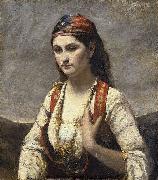 |
Jean-Baptiste Camille Corot
|
|
(July 17, 1796 - February 22, 1875) was a French landscape painter and printmaker in etching. Corot was the leading painter of the Barbizon school of France in the mid-nineteenth century. He is a pivotal figure in landscape painting and his vast output simultaneously references the Neo-Classical tradition and anticipates the plein-air innovations of Impressionism. |
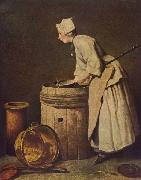 |
Jean Simeon Chardin
|
|
(2 November 1699 - 6 December 1779) was an 18th-century French painter. He is considered a master of still life, and is also noted for his genre paintings which depict kitchen maids, children, and domestic activities. Carefully balanced composition, soft diffusion of light, and granular impasto characterize his work.
Chardin was born in Paris, the son of a cabinetmaker, and rarely left the city. He lived on the Left Bank near Saint-Sulpice until 1757, when Louis XV granted him a studio and living quarters in the Louvre.
Chardin entered into a marriage contract with Marguerite Saintard in 1723, whom he did not marry until 1731. He served apprenticeships with the history painters Pierre-Jacques Cazes and Noël-Nicolas Coypel, and in 1724 became a master in the Academie de Saint-Luc.
According to one nineteenth-century writer, at a time when it was hard for unknown painters to come to the attention of the Royal Academy, he first found notice by displaying a painting at the "small Corpus Christi" (held eight days after the regular one) on the Place Dauphine (by the Pont Neuf). Van Loo, passing by in 1720, bought it and later assisted the young painter
|
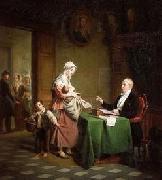 |
Jean Henri De Coene
|
|
Jean Henri De Coene, a Belgian painter of genre and historical subjects, was born at Nederbrakel in 1798. |
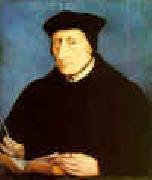 |
Jean Clouet
|
|
French Painter, ca.1485-1541
painter. He was chief painter to Francis I and produced many pastel portraits of members of the French court. Clouet was one of the best 16th-century portrait painters, both incisive and delicate in the psychological characterization of sitters. His drawings are simple, broad, and subtle; his paintings are fresh in colour, subdued in modeling, and minute in execution. He was celebrated in his lifetime as the equal of Michelangelo. His son Francois Clouet (c. 1515 ?C 72) took his place as official painter to Francis I in 1540. |
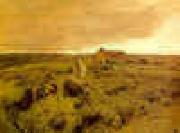 |
Jean Charles Cazin
|
|
1841-1901
French
Jean Charles Cazin Location
Painter and ceramicist. His earliest paintings reveal close affinities with the realist tradition, while his later compositions (mostly landscapes of northern France) demonstrate an awareness of Impressionism and a commitment to recording the changing effects of light and atmosphere. He was sent to England for health reasons but by 1862 or 1863 was living in Paris and active in avant-garde artistic circles. In 1863 he exhibited Recollections of the Dunes of Wissant (untraced), a work based on close observation of the coastline of northern France, at the Salon des Refuses. He enrolled at the Ecole Gratuite de Dessin under Horace Lecoq de Boisbaudran, where he became friends with Alphonse Legros, Thodule Ribot, Henri Fantin-Latour and Leon Lhermitte, all of whom adopted Boisbaudran method of developing paintings from memory as a way of heightening perceptions. During this period Cazin also met Marie Guillet, whom he married in 1868. |
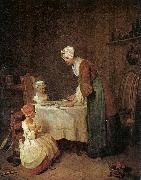 |
Jean Baptiste Simeon Chardin
|
|
1699-1779
French
Jean Baptiste Simeon Chardin Locations
Chardin was born in Paris, the son of a cabinetmaker, and rarely left the city. He lived on the Left Bank near Saint-Sulpice until 1757, when Louis XV granted him a studio and living quarters in the Louvre.
Chardin entered into a marriage contract with Marguerite Saintard in 1723, whom he did not marry until 1731. He served apprenticeships with the history painters Pierre-Jacques Cazes and Noël-Nicholas Coypel, and in 1724 became a master in the Acad??mie de Saint-Luc.
Upon presentation of The Ray in 1728, he was admitted to the Acad??mie Royale de Peinture et de Sculpture. The following year he ceded his position in the Acad??mie de Saint-Luc. In November of 1731 his son Jean-Pierre was baptized, and a daughter, Marguerite-Agn??s, was baptized in 1733. In 1735 his wife Marguerite died, and within two years Marguerite-Agn??s had died as well.
The Ray, 1728, Mus??e du Louvre, Paris.Beginning in 1737 Chardin exhibited regularly at the Salon. He would prove to be a dedicated academician, regularly attending meetings for fifty years, and functioning successively as counsellor, treasurer, and secretary, overseeing in 1761 the installation of Salon exhibitions.
In 1744 he entered his second marriage, this time to Françoise-Marguerite Pouget. The following year a daughter, Ang??lique-Françoise, was born, but she died in 1746.
In 1752 Chardin was granted a pension of 500 livres by Louis XV. At the Salon of 1759 he exhibited nine paintings; it was the first Salon to be commented upon by Denis Diderot, who would prove to be a great admirer and public champion of Chardin work. Beginning in 1761, his responsibilities on behalf of the Salon, simultaneously arranging the exhibitions and acting as treasurer, resulted in a diminution of productivity in painting, and the showing of replicas of previous works. In 1763 his services to the Acad??mie were acknowledged with an extra 200 livres in pension. In 1765 he was unanimously elected associate member of the Acad??mie des Sciences, Belles-Lettres et Arts of Rouen, but there is no evidence that he left Paris to accept the honor.[8] By 1770 Chardin was the Premiere peintre du roi, and his pension of 1,400 livres was the highest in the Academy.
In 1772 Chardin son, also a painter, drowned in Venice, a probable suicide. The artist last known oil painting was dated 1776; his final Salon participation was in 1779, and featured several pastel studies. Gravely ill by November of that year, he died in Paris on December 6, at the age of 80. |
 |
Jean Baptiste Camille Corot
|
|
1796-1875
Corot Locations
French painter, draughtsman and printmaker.
After a classical education at the College de Rouen, where he did not distinguish himself, and an unsuccessful apprenticeship with two drapers, Corot was allowed to devote himself to painting at the age of 26. He was given some money that had been intended for his sister, who had died in 1821, and this, together with what we must assume was his family continued generosity, freed him from financial worries and from having to sell his paintings to earn a living. Corot chose to follow a modified academic course of training. He did not enrol in the Ecole des Beaux-Arts but studied instead with Achille Etna Michallon and, after Michallon death in 1822, with Jean-Victor Bertin. Both had been pupils of Pierre-Henri Valenciennes, and, although in later years Corot denied that he had learnt anything of value from his teachers, his career as a whole shows his attachment to the principles of historic landscape painting which they professed. |
|

